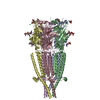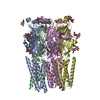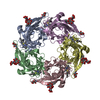+Search query
-Structure paper
| Title | Structural determinants for activity of the antidepressant vortioxetine at human and rodent 5-HT receptors. |
|---|---|
| Journal, issue, pages | Nat Struct Mol Biol, Year 2024 |
| Publish date | May 2, 2024 |
 Authors Authors | Uriel López-Sánchez / Lachlan Jake Munro / Lucy Kate Ladefoged / Anders Juel Pedersen / Christian Colding Brun / Signe Meisner Lyngby / Delphine Baud / Céline Juillan-Binard / Miriam Grønborg Pedersen / Sarah C R Lummis / Benny Bang-Andersen / Birgit Schiøtt / Christophe Chipot / Guy Schoehn / Jacques Neyton / Francois Dehez / Hugues Nury / Anders S Kristensen /     |
| PubMed Abstract | Vortioxetine (VTX) is a recently approved antidepressant that targets a variety of serotonin receptors. Here, we investigate the drug's molecular mechanism of operation at the serotonin 5-HT receptor ...Vortioxetine (VTX) is a recently approved antidepressant that targets a variety of serotonin receptors. Here, we investigate the drug's molecular mechanism of operation at the serotonin 5-HT receptor (5-HTR), which features two properties: VTX acts differently on rodent and human 5-HTR, and VTX appears to suppress any subsequent response to agonists. Using a combination of cryo-EM, electrophysiology, voltage-clamp fluorometry and molecular dynamics, we show that VTX stabilizes a resting inhibited state of the mouse 5-HTR and an agonist-bound-like state of human 5-HTR, in line with the functional profile of the drug. We report four human 5-HTR structures and show that the human receptor transmembrane domain is intrinsically fragile. We also explain the lack of recovery after VTX administration via a membrane partition mechanism. |
 External links External links |  Nat Struct Mol Biol / Nat Struct Mol Biol /  PubMed:38698207 PubMed:38698207 |
| Methods | EM (single particle) |
| Resolution | 2.98 - 3.3 Å |
| Structure data | EMDB-15689, PDB-8aw2: EMDB-15699, PDB-8axd: EMDB-16103, PDB-8bl8: EMDB-16104, PDB-8bla: EMDB-16105, PDB-8blb: |
| Chemicals |  ChemComp-NAG:  ChemComp-CL: 
ChemComp-VTX: |
| Source |
|
 Keywords Keywords |  MEMBRANE PROTEIN / Pentameric ligand-gated ion channel / MEMBRANE PROTEIN / Pentameric ligand-gated ion channel /  Serotonin receptor / vortioxetine / Human pentameric ligand-gated ion channel / Serotonin receptor / vortioxetine / Human pentameric ligand-gated ion channel /  Human serotonin receptor Human serotonin receptor |
 Movie
Movie Controller
Controller Structure viewers
Structure viewers About Yorodumi Papers
About Yorodumi Papers















